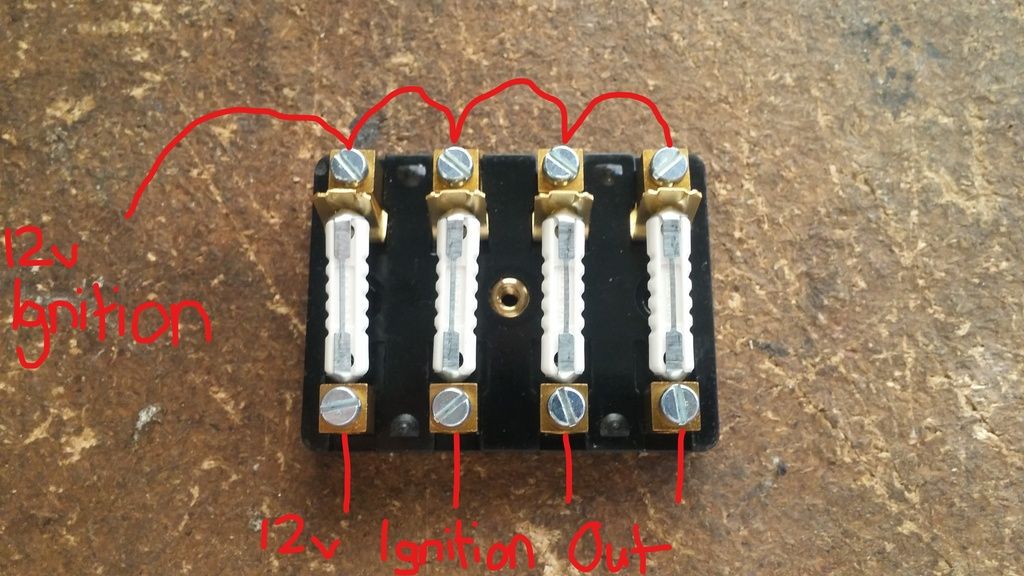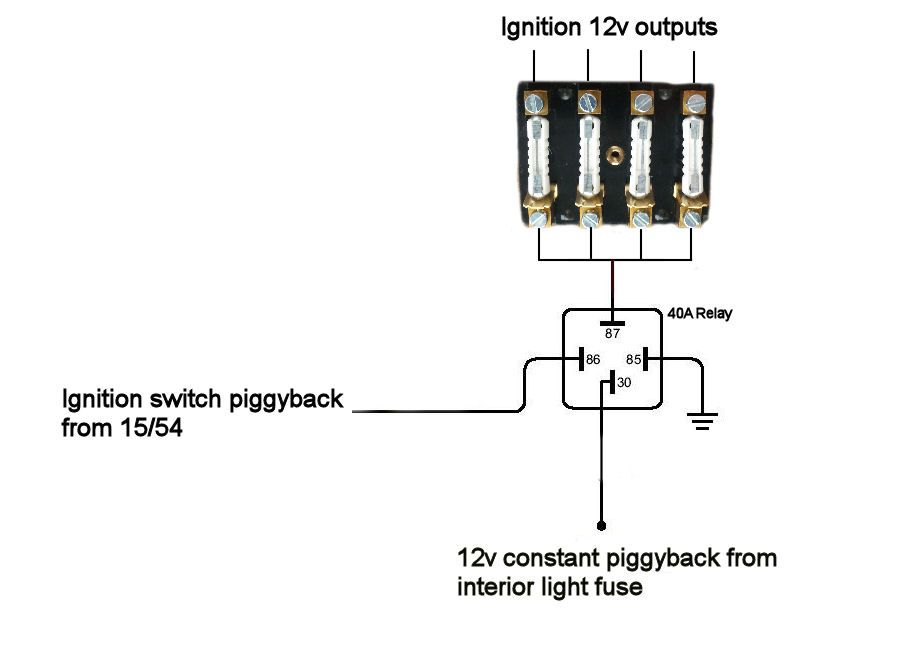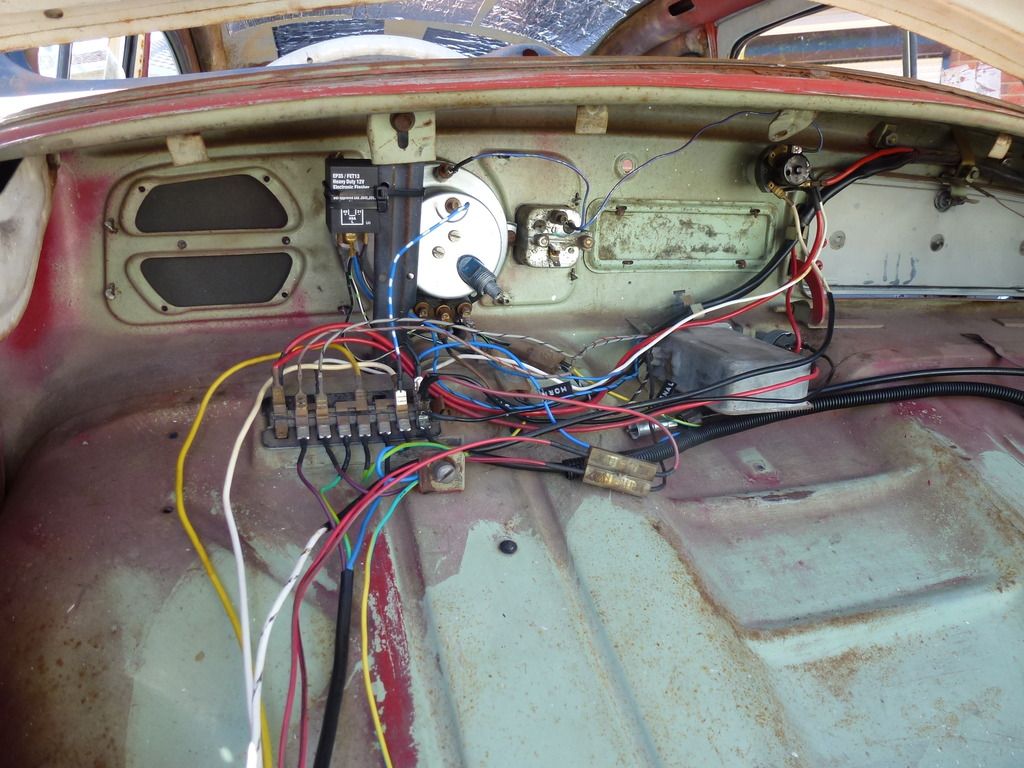
Electrical question
m4co - April 1st, 2017 at 01:46 PM
So I need more 12v outputs with Ignition but I don't want to overload the current output on the standard fuse box. I purchased another fuse panel and
I am a little confused as how to run 12v Ignition to it.
Should I just add a connector to the back of the ignition switch?
I have drawn on how I believe that it should be wired up but I would like an opinion as I am not that confident when it comes to modifying anything
electrical.

As the picture indicates I would like to run a cable from the ignition switch and connect it to all the tops of the fuses and then run any 12v outputs
from the bottom. Is this an acceptable way of doing so?
Thanks 
AA003 - April 3rd, 2017 at 06:33 PM
Keep it as close as possible to the ignition switch as the ignition switch is not fused.
You could also piggyback it from the original fuse panel ignition feed.
modnrod - April 3rd, 2017 at 07:51 PM
If you start drawing a heap of extra current, all of it still goes through the ignition switch........which is why the plastic bit melts (too much
heat).
If that is the case, then consider adding a big continuous duty solenoid (fancy name for a relay) to then power up your ignition circuit. The switch
then only carries less than 1Amp and will last forever. I can give you a diagram if you wish, or take it to a sparky for a stress-free upgrade for not
a lot.
psimitar - April 3rd, 2017 at 07:58 PM
The wire you use for the feed needs to be able to carry the current of all 4 fuses so with 4 x 8amp fues you have a maximum load of 32amps. So you use
wire of the correct size to carry that much load. Second thing is the ignition switch now has to carry that extra load and it's not such a good idea
to load the switch up that much as it makes it wear out quicker. Using a 40amp relay to feed the new fuse box would be a much better idea. The
ignition switch truns the relay on and you have a live feed from say the light switch to the relay to carry the fusebox feed.
Daisy chaining 10amp wire will work but if you run too much amps then you'll set fire to the 10amp wire. It's better to be safe rather than sorry
with electrics.
m4co - April 3rd, 2017 at 10:44 PM
Thanks for the input guys, I knew it was a good idea to post on here!
I have made a wiring diagram based on your suggestions, does it look correct? I mostly plan on using the power for a cigarette lighter socket so I can
charge my phone and power to a wireless Bluetooth speaker later on so I can listen to the radio without the need for a complete stereo.

Would 8 gauge wire be acceptable to use? I did some research and apparently it is rated to 40 amps
.
psimitar - April 4th, 2017 at 08:06 PM
The diagram looks spot on apart from the 12V feed to the relay. You need to use the thick red from either the ignition switch or the light switch.
Depending on the year of vehicle will dictate which is best.
As for the 8 gauge, I usuallly use a cheat sheet to look it up but if it's rated for 40amps at 12v then all good. You could even wire it direct to
the battery if trying to connect to the other wire I stated is troublesome.
psimitar - April 5th, 2017 at 07:45 PM
| Quote: |
Originally
posted by AA003
| Quote: | Originally
posted by psimitar
The diagram looks spot on apart from the 12V feed to the relay. You need to use the thick red from either the ignition switch or the light switch.
Depending on the year of vehicle will dictate which is best.
As for the 8 gauge, I usuallly use a cheat sheet to look it up but if it's rated for 40amps at 12v then all good. You could even wire it direct to
the battery if trying to connect to the other wire I stated is troublesome.
|
How about you let me know what model vehicle that you have and how many fuses the original fuse box has and I can design something really nice for
you.
|
Um, I'm not the one wanting the extra fusebox so unsure why you quoted what I said? Confused?
AA003 - April 5th, 2017 at 08:07 PM
| Quote: |
Originally
posted by m4co
So I need more 12v outputs with Ignition but I don't want to overload the current output on the standard fuse box. I purchased another fuse panel and
I am a little confused as how to run 12v Ignition to it.
Should I just add a connector to the back of the ignition switch?
I have drawn on how I believe that it should be wired up but I would like an opinion as I am not that confident when it comes to modifying anything
electrical.
As the picture indicates I would like to run a cable from the ignition switch and connect it to all the tops of the fuses and then run any 12v outputs
from the bottom. Is this an acceptable way of doing so?
Thanks 
|
How about you let me know what model vehicle that you have and how many fuses the original fuse box has and I can design something really nice for
you.
m4co - April 11th, 2017 at 12:09 PM
| Quote: |
Originally
posted by AA003
| Quote: | Originally
posted by m4co
So I need more 12v outputs with Ignition but I don't want to overload the current output on the standard fuse box. I purchased another fuse panel and
I am a little confused as how to run 12v Ignition to it.
Should I just add a connector to the back of the ignition switch?
I have drawn on how I believe that it should be wired up but I would like an opinion as I am not that confident when it comes to modifying anything
electrical.
As the picture indicates I would like to run a cable from the ignition switch and connect it to all the tops of the fuses and then run any 12v outputs
from the bottom. Is this an acceptable way of doing so?
Thanks 
|
How about you let me know what model vehicle that you have and how many fuses the original fuse box has and I can design something really nice for
you.
|
It is a 1966 with 8 available fuses

AA003 - April 11th, 2017 at 04:08 PM
One end of your fuse panel are large red cables that are B+. Connect a large red cable (4sqmm) from the top terminal to 30 on your relay. Keep this as
short as possible as it is permanently live and not fused.
The other end of the fuse panel are black cables that are ignition live (15). Connect a thin black from the top terminal to 86 on your relay.
Run a small brown from relay terminal 85 to a good earth point. The black and brown only need to be thin as they have low load (around 1 sqmm)
Try to buy a relay that has 2 terminal 87. (Not a 87 and 87a). This will make it easier to connect multiple cables to your new fuse panel. You will
then only need to piggyback 2 cables at your relay or fuse panel.
psimitar - April 11th, 2017 at 06:33 PM
I've not found an online supplier in Oz for uninsulated terminals but I use Vehicle Wiring products in the UK. Postage is pretty cheap and fairly
quick, depending on AusPost. Anyhow, there you can buy spade terminals that can accept some pretty large cable sizes. Just makes doing double or even
triple wire terminations to a single connector far easier. 
AA003 - April 12th, 2017 at 06:21 AM
Actually I have all of the equipment to make a loom if you wish. Probably even supply a double pole relay. Postage would be the biggest cost.





